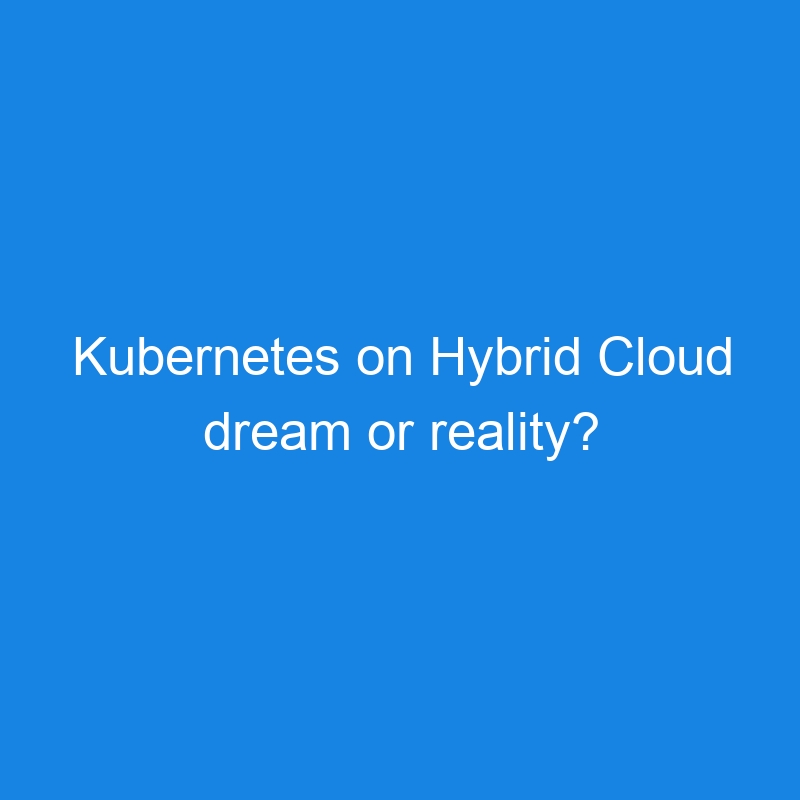Many organizations are interested in running Kubernetes on a hybrid cloud setup. This usually becomes a priority after major outages in their data centers or receiving unexpectedly high bills from their cloud provider. The goal is to leverage the flexibility and scalability of Kubernetes while avoiding vendor lock-in.
What is Hybrid Cloud
Running Kubernetes on a hybrid cloud means operating a single Kubernetes cluster across on-premises infrastructure and public cloud environments. Public clouds might include well-known providers such as AWS, Azure, or Google Cloud, while private clouds could involve platforms like OpenStack, Proxmox, or even bare-metal servers.
Benefits of Hybrid Cloud Kubernetes:
- Cost Efficiency: Run baseline workloads on bare-metal servers and scale using public clouds when extra capacity is needed.
- Flexibility: Choose the best cloud provider for specific workloads based on cost or performance.
- Unified Management: Manage all workloads from a single Kubernetes cluster.
- Vendor Independence: Avoid being locked into a single cloud provider.
- Database Solutions: Run database operators directly on Kubernetes, similar to how managed databases work in the cloud.
- Disaster Recovery: Keep standby nodes in the cloud for quick failover during outages.
Challenges of Running Kubernetes on Hybrid Cloud
While the benefits are significant, running Kubernetes on a hybrid cloud is not without challenges:
- Cloud Integration: Native integration with cloud services is essential for smooth operation.
- Networking: Secure and reliable connections between on-premises and cloud environments are crucial.
- Latency: Minimize latency by optimizing traffic routing.
- Security: Implement robust measures to secure workloads and data across environments.
Existing Solutions for Hybrid Kubernetes
Kubernetes already offers several tools and features for managing hybrid cloud clusters effectively:
- Talos: A secure, immutable, and minimal operating system designed for Kubernetes.
- Cloud Controller Manager: Helps manage Kubernetes nodes in cloud environments.
- Persistent Volumes: Support for multiple storage types, enabling on-premises and cloud storage usage within the same cluster.
- IPv6 for Pods and Services: Allows seamless pod-to-pod communication without the need for NAT.
- Internal Traffic Policy: Controls how traffic is routed within the cluster.
- Topology Aware Routing: Optimizes network traffic routing based on the physical location of nodes.
- Traffic distribution: Distributes traffic across multiple zones.
Networking Setup
Networking is one of the most important aspects of a hybrid Kubernetes cluster. You must ensure:
- A secure VPN or direct connection between on-premises and cloud networks.
- Consistent IP addressing and DNS resolution.
- Proper network policies for traffic management.
- Load balancing across on-premises and cloud environments.
Network architecture is very important for hybrid cloud Kubernetes. It very hard to change after the cluster is up and running.
Cluster Configuration
When setting up your cluster:
- Define which workloads run on-premises and which in the cloud.
- Use node selector/affinity to control where specific pods run.
Control plane configuration
Kubernetes uses etcd as its database to store cluster state. It is crucial to ensure etcd remains highly available and secure. Here are some best practices:
- Use an odd number of etcd nodes: This ensures high availability and avoids split-brain scenarios.
- Run across multiple availability zones or cloud providers: Ensure low latency between nodes and select providers with minimal latency.
- Regularly back up etcd data: Prevent data loss with automated backups.
- Disaster Recovery Plans: Test and train disaster recovery plans for etcd failures.
Cloud integration
Most of the cloud providers offer addons to integrate with Kubernetes. These addons was disaigned to run on the cloud provider’s Kubernetes service. However, you can run them on your hybrid cluster as well, with some modifications.
- CCM (Cloud Controller Manager) requires the changes in the code, check my already modified version
- CSI (Container Storage Interface) is a standard for exposing storage systems to containerized workloads on Kubernetes. Most of them works well in hybrid cloud setup.
- Cluster Node Autoscaler also requires some changes
Monitor and Optimize
Monitoring tools like Prometheus and Grafana can help track the health and performance of your hybrid cluster. Additionally:
- Use autoscalers to manage resource usage efficiently.
- Set alerts for potential issues.
- Regularly review and optimize your cluster setup.
Conclusion
Running a Kubernetes cluster in a hybrid environment offers flexibility and scalability, but it requires careful planning and execution.
To find out more about Kubernetes on hybrid cloud, check out the following resources:
- Talos on Hybrid Cloud to deploy Talos on different cloud providers
- Fluxcd to install base addons in hybrid cluster
- Container images with modified cloud addons
- Helm charts for deploying applications in hybrid cluster
